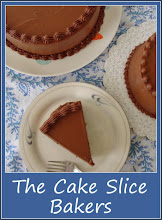 This month's challenge is brought to us by the adventurous Hilda from Saffron and Blueberry and Marion from Il en Faut Peu Pour Etre Heureux.They have chosen a French Yule Log by Flore from Florilege Gourmand
This month's challenge is brought to us by the adventurous Hilda from Saffron and Blueberry and Marion from Il en Faut Peu Pour Etre Heureux.They have chosen a French Yule Log by Flore from Florilege GourmandWhat is a French Yule Log and how is it different from the Yule Log I made last December with the Daring Bakers? In France you can buy two kinds of Yule log, either a Genoise and Buttercream log shaped cake , or a frozen Yule Log containing many different layers including Dacquoise Biscuit, Chocolate Mousse, Ganache, Praline Crisp, Crème Brulee and Chocolate Icing. That’s right 6 components and the mousse and dacquoise biscuit can make more than one layer! I’m sure you can understand how I sank to the floor in a daunted state of disbelief upon reading the 18 page document that made up the recipe. Thankfully nearly half of that were options on flavour variations for the components but it still results in the most multi stage/component recipe I have ever made. That being said, once I had sorted out the recipe in my head I found each component to be relatively straight forward and apart from the chocolate icing (which is best made the day you serve it) I got the challenge completed in one day without any disasters. The log is frozen overnight before being turned out and covered in a glossy chocolate icing before being returned to the freezer for a few hours before serving.

We could choose what shape to make our ‘logs’ but I decided to go with a loaf tin instead of a cake tin to try and resemble the thinner shape of a log. We were given many options for flavours but I decided to keep things quite simple as I was serving the dessert on Christmas day and wanted to make something I knew everyone would eat. My dacquoise biscuit was made with ground almonds and is similar to a genoise you make for a swiss roll. Once baked, I then cut around the base and top of my loaf tin to get the correct sized layers. The mousse and ganache were half milk, half dark chocolate, the praline crisp hazelnut and the crème brulee vanilla and I love the resulting pale streak in the middle of the log. The chocolate icing and mousse both call for gelatin, but as I’m Vegetarian I left this out. We were told that we could use agar agar if we didn’t want to use gelatin, but I read the recipe and couldn’t see a reason why gelatin was needed in the first place, especially as the whole dessert is frozen so I skipped that part completely and my dessert didn’t suffer in the slightest. If anything I suspect it turned out smoother and creamier than if I had used gelatin as this would have given it a slight gelatinous consistency, which I don’t like.

The chocolate mousse component in its unfrozen state is just divine. I was initially a little concerned as my mousse was very thick and stiff but as I mixed, it suddenly transformed into a rich and creamy mousse that was velvety smooth. I couldn’t help eating a few spoonfuls before it even got near the tin. I plan to make this again and serve it in little espresso cups, it was so good.

I pleased to say it went down very well with everyone on Christmas day, the only thing I would change if I made it again is to try and flatten my praline crisp into a thinner layer as it was rather thick, but this wasn’t particularly a bad thing. Once again, I’m so pleased the Daring Bakers made me make something I wouldn’t normally have attempted, as the results were well worth the effort.
 Don’t forget to check out the other Bakers Yule Logs and click here for the recipe.
Don’t forget to check out the other Bakers Yule Logs and click here for the recipe.




 I then made some tiny berries and dyed the last of my icing brown for the pine cones. I wasn’t sure these were going to work but I had an idea in my head of forming a cone shape out of fondant and then using small sharp scissors to made little cuts all over them. I gave it a go and I think it looks quite effective.
I then made some tiny berries and dyed the last of my icing brown for the pine cones. I wasn’t sure these were going to work but I had an idea in my head of forming a cone shape out of fondant and then using small sharp scissors to made little cuts all over them. I gave it a go and I think it looks quite effective. I had a few scraps of coloured icing left over and decided to make a little cheerful robin too. Use a paint brush and a little glace icing or clear alcohol to stick the shapes in place. And…. finito!
I had a few scraps of coloured icing left over and decided to make a little cheerful robin too. Use a paint brush and a little glace icing or clear alcohol to stick the shapes in place. And…. finito!


 Ingredients – for the cake layers
Ingredients – for the cake layers






 Ingredients
Ingredients


 Ingredients
Ingredients


 Ingredients
Ingredients





